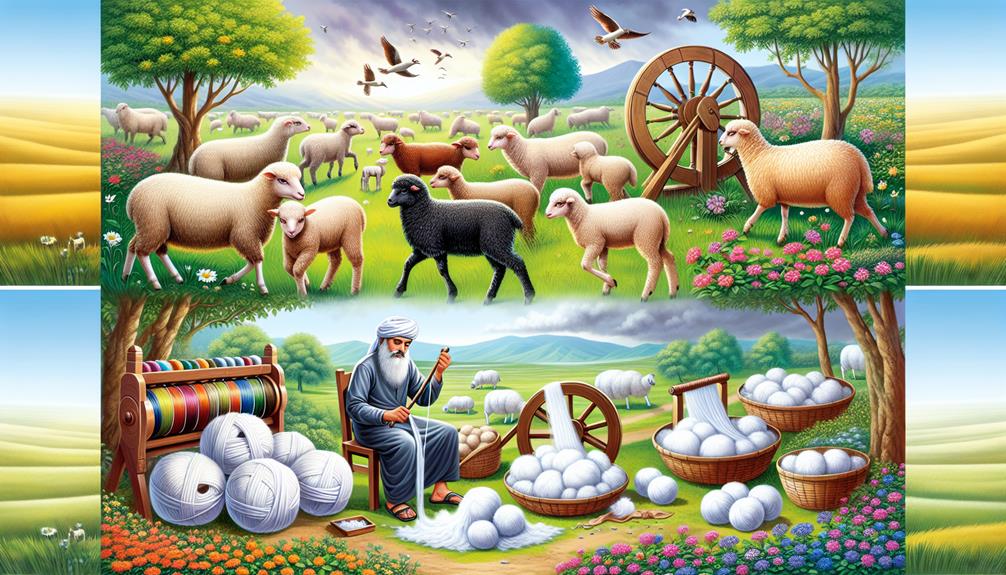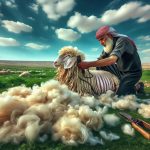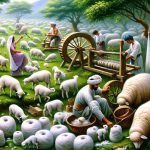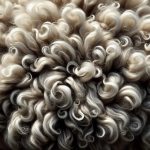I've got you covered on wool sources and uses! Wool comes from animals like sheep, goats, camels, and rabbits. It's highly valued for its quality and softness, with Australia being the top producer. The process involves shearing, cleaning, spinning, and weaving to create durable and versatile fabrics. From cozy wool coats to flame-resistant carpets and sports gear, wool finds its way into fashion, home furnishings, and even construction materials for added strength. Curious to discover more about the world of wool and its sustainable practices?
Table of Contents
Key Takeaways
- Wool is sourced from animals like sheep and goats.
- Types include Merino, Cashmere, and Angora wool.
- Used in fashion for coats, suits, and dresses.
- Commonly found in home furnishings like carpets and blankets.
- Industrial applications include fire retardant materials and packaging.
Wool Sourcing
Wool sourcing involves obtaining fibers from various animals like sheep, goats, camels, rabbits, and others. Australian wool, particularly from Merino sheep, is highly valued for its quality and softness. Merino wool fibers are known for being fine and comfortable against the skin due to their smaller diameter compared to other types of wool. These fibers are composed of keratin, a protein that gives wool its durability and elasticity.
Australia plays a significant role in the global wool market, being the largest producer with 98% of its wool being exported worldwide. The country's vast landscapes provide ideal conditions for raising Merino sheep, ensuring a consistent supply of high-quality wool. The wool industry in Australia adheres to strict standards of animal welfare and sustainable practices to maintain the quality and reputation of Australian wool in the international market.
Animal Sources of Wool
I'll start by talking about the animals that provide wool.
Sheep, goats, camels, and rabbits are the main sources of this natural fiber.
Each animal produces wool with unique qualities that are used across different industries.
Sheep Wool Types
From Merino sheep comes Merino wool, renowned for its softness and fineness. When it comes to sheep wool types, there are various options to choose from:
- Merino Wool: Known for its exceptional softness and fineness.
- Cashmere Wool: A luxurious fiber obtained from Cashmere goats.
- Angora Wool: Prized for its softness and warmth, sourced from Angora rabbits.
Each of these wool types has unique characteristics that cater to different needs and preferences. Whether you prioritize softness, luxury, or warmth, there's a sheep wool type that suits your requirements.
Wool Production Process
Obtaining wool involves a meticulous process that starts with sourcing it from various animals like sheep, goats, camels, rabbits, and more. The fiber obtained from these animals contains keratin, a natural protein that gives wool its unique properties.
The wool production process begins with shearing the animals to collect the raw wool. Next, the wool goes through cleaning, carding, spinning, and weaving to create different types of wool such as Angora, Lambswool, and Cashmere. These varieties offer distinct characteristics suitable for various applications.
Whether crafting heavy winter garments or lightweight summer fabrics, wool's insulating qualities make it a versatile choice. Overall, the wool production process transforms animal fibers into the versatile material we use in clothing, blankets, carpets, and more.
Wool Production Process
How is wool produced from animals like sheep, goats, and rabbits for various practical applications? Wool production involves a series of steps to transform raw wool fibers into usable material for textiles.
Here is an overview of the wool production process:
- Shearing: Wool is sheared from animals like sheep, goats, and rabbits.
- Cleaning and Scouring: The wool undergoes cleaning and scouring processes to remove impurities.
- Processing and Categorizing: The wool is processed and categorized into fleece, broken, bellies, and locks for different applications.
These steps are essential for preparing wool fiber, a valuable textile fiber, for use in a wide range of products such as clothing, blankets, carpets, and insulation. Raw wool must be carefully handled, classed by diameter and style, and graded to guarantee its quality and suitability for specific end uses.
Wool Characteristics and Qualities
When exploring wool characteristics and qualities, one immediately notices its natural resistance to wrinkles, stains, and flames. Wool's unique properties make it an ideal material for making durable wool fabrics and apparel wool.
The fibers in wool, composed of keratin, provide elasticity and warmth, ensuring comfort in various climates. Wool's moisture-wicking abilities allow it to absorb up to 30% of its weight in moisture, keeping the wearer dry and comfortable. Additionally, wool is biodegradable and sustainable, aligning with eco-conscious values.
Its luxurious feel adds to its popularity across different applications, from cozy sweaters to elegant suits. Whether used in crafting cozy blankets or high-end suits, wool's qualities shine through, making it a versatile and timeless choice for a wide range of clothing and textile needs.
Wool in Clothing and Fashion
Moving from exploring wool characteristics and qualities, the application of wool in clothing and fashion showcases its versatility and timeless allure in creating luxurious and functional garments.
Wool clothes are widely used in various fashion pieces due to their exceptional properties:
- Wool coats: Made of wool, these coats aren't only stylish but also provide excellent warmth and durability.
- Wool suits: Widely used in the fashion industry, wool suits are favored for their classic look, comfort, and ability to maintain shape.
- Wool dresses: Whether for formal events or casual outings, wool dresses made of this natural fiber offer a unique blend of elegance and comfort.
The adaptability of wool in clothing design allows for a wide range of styles and functions, making it a staple in the fashion world. Designers continue to explore innovative ways to incorporate wool into modern trends, showcasing its enduring appeal and practicality.
Wool in Home Furnishings
I love how wool brings warmth and durability to our home furnishings.
Wool carpets not only add a cozy touch but also offer natural fire resistance.
Plus, wool blankets are a must for quality bedding that keeps us snug and comfortable.
Wool Carpets Benefits
Benefiting from their exceptional durability and natural properties, wool carpets are a wise investment for households seeking safety, comfort, and sustainability in their home furnishings. Wool carpets offer longevity and natural flame resistance, providing a safe and cozy environment for families.
In addition, the insulation properties of wool help regulate room temperature, creating a comfortable space all year round. These carpets are also stain-resistant and moisture-repellent, making maintenance a breeze.
Furthermore, choosing wool carpets contributes to environmental sustainability as they're eco-friendly and biodegradable. With wool carpets, you not only enhance the aesthetics of your home but also prioritize safety, comfort, and eco-consciousness.
Wool Blankets Quality
When considering home furnishings, wool blankets stand out for their exceptional quality and warmth, making them a popular choice for cold weather conditions.
Wool blankets are made from wool, commonly sourced from Australian sheep, known for producing high-quality wool fibers. The natural properties of wool make these blankets durable and long-lasting, providing excellent value for their investment. Additionally, wool blankets have inherent fire-retardant features, enhancing safety in households.
These blankets are versatile, used in bedding and as throws on sofas to add both comfort and style to a room. With excellent moisture-wicking capabilities, wool blankets keep sleepers dry and cozy throughout the night, ensuring a restful sleep in any season.
Wool in Industrial and Construction Uses
In industrial and construction settings, wool serves as a versatile and valuable material due to its unique properties and applications. Wool is utilized as a fire retardant in construction due to its natural flame-resistant properties. Additionally, wool-insulated packaging boxes are used to provide protection and insulation for delicate items during transportation. Wool-strengthened bricks incorporate wool fibers for added strength and durability in construction materials.
Wool's natural flame resistance makes it an ideal choice for use in construction, providing safety and protection against fires. The insulation properties of wool are also harnessed in packaging to safeguard fragile items during transit, ensuring they reach their destination unscathed. In addition, the incorporation of wool fibers in construction materials like bricks enhances their structural integrity, making them more robust and long-lasting. Wool's diverse applications in industrial and construction settings highlight its versatility and importance in various practical contexts.
Wool in Sports Equipment
Wool plays a crucial role in enhancing the durability and impact absorption properties of various sports equipment, such as baseballs. The wool yarn winding inside baseballs helps them maintain their shape and structure during intense gameplay, making them resilient to high-velocity pitches. This natural resilience of wool is also why it's used in padding for sports equipment like pianos, effectively absorbing impacts and vibrations.
New South Wales, a leading producer of wool, particularly Australian Merino, contributes greatly to the quality and availability of wool for sports equipment manufacturing. The utilization of wool in sports equipment not only showcases its versatility but also highlights its longevity in demanding athletic applications.
Whether it's providing cushioning in baseballs or absorbing shocks in other sports gear, wool's unique properties make it a valuable component in ensuring the safety and performance of athletes across various sports.
Sustainable Practices in Wool Production
Implementing sustainable practices in wool production involves utilizing regenerative farming techniques to enhance soil health and biodiversity. In Australia, where sheep farming is prevalent, woolgrowers are increasingly adopting environmentally friendly methods to guarantee the long-term viability of their operations.
Some key practices include:
- Implementing regenerative farming techniques like holistic planned grazing to improve soil health and promote biodiversity.
- Utilizing water conservation methods such as rainwater harvesting and efficient irrigation systems to minimize water wastage.
- Investing in renewable energy sources like solar panels to reduce the carbon footprint of wool farms.
Frequently Asked Questions
What Are the Main Uses of Wool?
I'll tell you about the main uses of wool. It's in clothing, like coats and dresses, for warmth and durability. Also, think about carpets and rugs for their fire-resistant qualities and toughness.
What Are the Other Sources of Wool?
Other sources of wool besides sheep include goats (cashmere), rabbits (angora), camelids (alpaca, llama), and muskox (qiviut). These animals provide fibers with unique qualities like softness, warmth, and hypoallergenic properties, ideal for various garments.
What Source Is Wool Obtained From?
I get wool from animals like sheep, goats, camels, alpacas, and rabbits. Among them, sheep, especially Merino sheep, are the main source. Wool fibers are made of keratin protein, giving them unique properties.
What Resources Are Used to Make Wool?
To make wool, resources like sheep, goats, camels, and rabbits are used. These animals provide fibers that are spun into yarn. The process involves shearing, cleaning, carding, spinning, and weaving to create a versatile material for warmth and comfort.
- Tetron Fabric for Marine Applications: Durability and Use Cases - June 18, 2025
- Tetron Fabric for Outdoor Furniture: Weather Resistance and Care - June 18, 2025
- Tetron Fabric for Wall Coverings: Style and Application Tips - June 18, 2025







